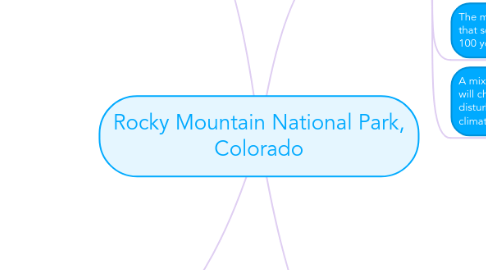Rocky Mountain National Park, Colorado
by Haley Langebrake


1. History & Culture
1.1. With the 1803 Louisiana Purchase, the U.S. government acquired the land now known as Rocky Mountain National Park.
1.2. In 1915, private lands dotted the park and many of these hosted guests since the turn of the century.
1.3. Numerous national environmental laws passed in the late 1960s and early 1970s changed the way the National Park Service managed its lands.
1.4. In the 1970s, Park Superintendents began to manage crowds in the park through assigned back country camp sites and shuttle buses.
2. Educational Information
2.1. The park offers field trips to multiple sites to take learning outside the classroom.
2.1.1. 1st Sitting
2.1.2. 2nd Sitting
2.1.3. 3rd Sitting
2.2. Teacher Guides will provide you with in-depth knowledge about the park with topics ranging from geology to fire ecology and beyond.
2.3. An online resource helps teachers explore various subjects from all national park units.
2.3.1. Essay exam
2.3.2. Oral exam
2.3.3. Multiple choice
2.4. The education program at Rocky Mountain National Park host 2-4 interns each season, in which interns assist park staff with the development and administration of the edcuation program.
3. Nature
3.1. The park is home to hundreds of different kinds of wildflower species in the highest and lowest elevations.
3.2. Every ecosystem of the park is inhabited by animals consisting of mammals, amphibians and reptiles, birds, fish, insects, and threatened and endangered species.
3.2.1. Name
3.2.2. Office hours
3.2.3. Contact
3.3. Rocky Mountain National Park is one of the highest parks is the nation, with elevations from 7,860 feet to 14,259 feet, with multiple climatic divisions.
3.4. The mountains are also full of natural resources that scientist have been researching for over 100 years.
3.5. A mixture of tons of plants forms a climax vegetation that will change over time unless disrupted by natural disturbances such as avalanches, wind storms, floods or climate change.
3.5.1. E-learning
3.5.2. Student forum

